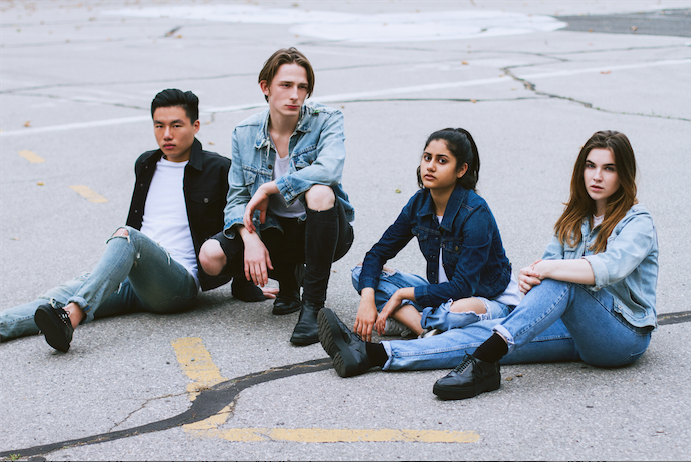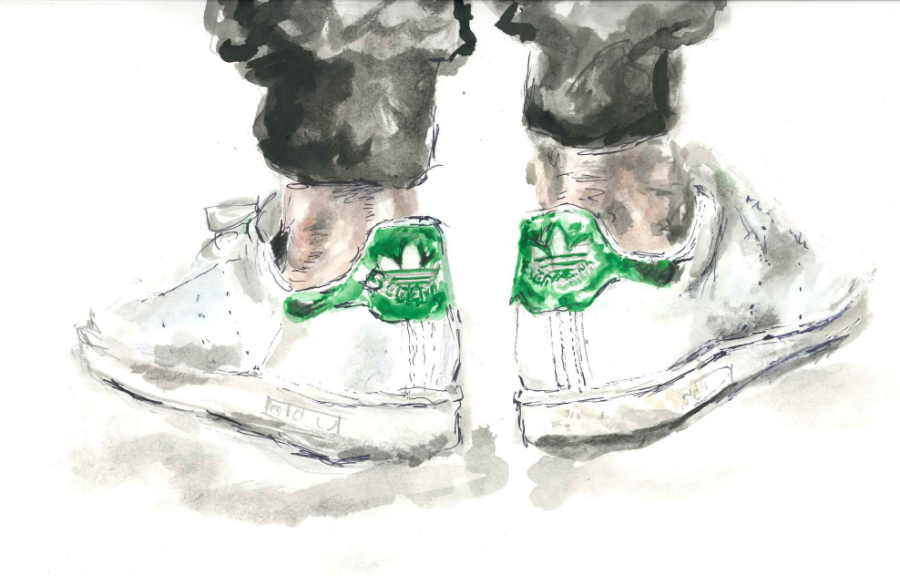FRINGE
November 19, 2015
Letter from the editors
Since its inaugural issue, Fringe has sought to capture the unconventionality of the fashion world in the glossy pages of a magazine. While this season’s “Back to Basics” aesthetic seems contradictory to the foundations of Fringe, it is actually quite appropriate in its embrace of the quotidian — a notion “on the fringe” of fashion itself.
From turtlenecks to the iconically trendy Stan Smith sneaker, every article of clothing in this issue was either selected from the creative team’s own closet or graciously provided by Lacoste. Together, the worn-in pieces layered with designer items show just how accessible fashion truly is.
With a little black dress and a solid gray coat, we reclaim “basic” for its original meaning, disregarding its contemporary, negative connotations. With a call to action, we challenge the lack of diversity so pervasive in this industry and celebrate the progress being made. We look to a graduate who is living proof that passion and dedication will take you places. Finally, we recognize that in its ever-shifting nature, fashion continues to evolve from the very ashes it burns.
Thank you to our amazing writers and multimedia team, especially Polina, Tatiana, Jack, Calvin and Prissilya. To our models, Conrad, Kirra, Adryan and Rukhshana and our beauty artist Dana Reszutek, thank you. And finally, thank you to Olivia and Valentina for helping us create such a beautiful issue.
Basic bitches no more
The term “basic,” often in tandem with another word that begins with the letter B, has evolved from previous understandings of wardrobe essentials, pH scale references and fundamental principles into a pejorative descriptor for those who enjoy mainstream products or music. This expanding new usage has come to represent a culture of material consumption with no regard to long term value and meaning.
“Basic” is the antonym of all that hipsters stand for in their desperate race to avoid accusations of gentrification, the Billboard Top 40 and anything resembling a label — two simultaneous movements that represent a polarizing shift in young adult interests. This emerging group of younger trend followers carries the stigma of lacking sophistication, intelligence or any defining characteristics and, despite recent efforts from within the mainly Caucasian subgroup to retake and redefine the word, carries decidedly negative connotations.
While this particular usage of the word can be seen as early as 1985, by the all-girl R&B group Klymaxx, the term didn’t gain much traction until 2013. The use of “basic” in terms of wardrobe selection, however, emerged during the mid 2000s while collections of pieces themselves and the idea of wardrobe staples had already been decades in the making.
This definition carries connotations of the classic and the timeless, bringing to mind the historically esoteric and desperately sought after Little Black Dress, a perfectly fitted, crisp white button-down and a Breton-striped shirt Coco Chanel herself would wear. The woman whose closet revolves around these key, style basics carries a fundamental understanding of timeless fashion and commands the respect and attention of her peers.
To obtain a sufficient grasp on the term as a whole and its relevance within fashion, a distinction between the two meanings must be established. Wardrobe basics represent monetary efficiency and the blood, sweat and tears of older generations who spent countless seasons testing wardrobe staple contenders before settling on the chosen few. Conversely, this emerging slang variation brings to mind trendy pieces that quickly dissolve into irrelevancy, a near opposite of the original definition.
A quick google search of basic picks up thousands of hits, everything from “Wardrobe Staples – Everyday Basics Your Closet Needs” to “How to Avoid Dressing Like a Basic Bitch.” With such an obvious contradiction between the two, it can be hard to pinpoint the connection that led to their shared linguistic derivative. Perhaps this link can be traced to the association of both with items that saturate the market. Yet even then, in the case of basic in the slang sense, this saturation exists in the short term while wardrobe essentials are consistently prevalent, mainstays in any closet.
Accepting and understanding these two meanings, as well as obtaining the ability to differentiate between them, is the first step toward reclaiming “basic” within the fashion industry. By their own definition, these staples will far outlive the slang term whose significance will soon fade into the annals of pop culture along with buggin, home skillet and fugly, all abandoned by the flitting attention span that characterizes young adults. In the meantime, hold on tight to those white sneakers and flattering, light-wash jeans while this colloquialism, and the flashy trends associated with it, runs its course.
Email Grace Dixon at [email protected].
It’s something to talk about
As the saying goes, “if you see something, say something.” It is impossible to overlook the fact that models on runways and faces in ad campaigns all look the same. We have all seen the lack of diversity in the fashion industry for far too long, and it is time to say something.
Following the Spring/Summer 2016 runway season, The Fashion Spot compiled data from 373 fashion shows and 9,926 model appearances from New York, London, Paris and Milan. They found that 77.6 percent of the runway models were white. The same study also showed that, after examining 460 print ads, 84.7 percent of the models cast were white.
The fashion industry is one of the leading driving forces behind what the public perceives as beautiful. When the diversity on the runway and within magazine pages is limited to a handful of faces, that perception of a normative beauty standard narrows even more.
“We are drawn to people who look like us,” Robin Givhan of The Washington Post said to Business of Fashion. “Unless they’re making a conscious decision to deviate from the standard, then the standard is what they go for. And [their] standard is blonde and blue eyed.”
It seems to be a never-ending cycle, but the first step towards a solution is recognizing that there is a problem and then talking about it. Publications including the Man Repeller have also made an effort to discuss the lack of diversity, saying, “Conversation is part of the solution.”
Former model and activist Bethann Hardison is one of the key proponents in the fashion diversity conversation as well. Hardison founded Diversity Coalition/Balance Diversity to encourage the industry to keep racial diversity in mind when casting models.
“Our objective is to make a shift on how the model of color is viewed so it becomes natural to see them participating each season in a greater number than seasons past,” reads the Balance Diversity website.
Another step toward more active inclusion from the inside out is increasing the industry’s diversity. If the designers, stylists, agencies and editors don’t diversify their employees, then there’s a greater chance that that low level of diversity will translate to what the public sees. Fashion editor Shiona Turini spoke with the Man Repeller on the importance of this performative solution.
“Don’t just look at the runway,” Turini said. “Look around at who is sitting next to you at fashion week.”
The New York Times found that of the 470 designers in the Council of Fashion Designers of America, only 12 are African-American designers. Designer Tracy Reese told Business of Fashion, “More often, [I’m] the only person of color in the room.”
Perhaps the best step to be taken is celebrating the diversity that does happen in the industry. If the public doesn’t know about it, the public won’t talk about it. While identifying where problems persist is of the utmost importance, pointing out who has solutions to offer should not go unnoticed either. Aurora James of Brother Vellies was the first black woman to receive the CFDA/Vogue Fashion Fund award. Teen Vogue editor-in-chief Amy Astley chose to spotlight models of color Aya Jones, Lineisy Montero and Imaan Hammam as “fashion’s new faces” in the August issue.
We can celebrate diversity in an even more inclusive sense as well. Madeline Stuart, an 18-year-old model with Down syndrome, opened the Hendrik Vermeulen NYFW Spring/Summer 2016 runway show. Ashley Nell Tipton, Project Runway’s latest winner, made the show’s history as the first designer of plus-sized fashion. Transgender designer Gogo Graham created a runway show in New York that featured only trans models.
These are the names that should be making more headlines in celebration. Praise and positive reinforcement keep the call for change going. We should never stop addressing what is wrong, but we certainly cannot be afraid to point out what is right either.
Email Natalia Barr at [email protected].
Learn from the master
The fashion industry is growing, but it remains difficult to break into. With New York City as a student’s backdrop, the fashion capital of the world teaches fashionistas to be assertive and determined. One such graduate of NYU was able to become part of this intimidating, sartorial realm of the city.
Jackie Kim, class of 2015, studied the Business of Fashion and French Language in the Gallatin School of Individualized Study and is now following her dreams, which, coupled with hard work and dedication, landed her a position as the Fashion Merchandising Assistant to the Fashion Office at Barneys New York. During her time at NYU, Kim was able to intern with Annie Leibovitz, at Vanity Fair, Refinery 29, Chanel and Barneys New York. In fact, Kim interned at Barneys in the summer of 2013 and worked three separate terms until she was hired in May of 2015.
“I feel a fierce loyalty to Barneys for the mentorship I’ve received throughout my pre-professional and professional career,” Kim said.
As a Fashion Merchandising Assistant today to Barneys’ Senior Fashion Director, Tomoko Ogura, Kim has been busy working on various projects. Her favorites include styling for Barneys’ luxury editorial site, The Window, meeting new vendors and collaborating with designers to develop exclusive styles.
As a student at NYU, Kim always had an affinity for fashion, beginning her passion with an interest in photography. However, as she frequented photo shoots during her internships, she found herself drawn to the stylists and the clothes. “After my photo internship ended, I told myself to try a fashion internship to see how I liked it,” Kim said. “Once I made the decision to try a fashion centric role, I never looked back.”
In looking at the huge role NYU played in securing her a position at Barneys, Kim reflected on all aspects of her time as a student.
“My classmates and professors were perhaps my greatest advantages, as they challenged my state of mind,” Kim said.
“Being surrounded by overachievers who were dedicated to multiple projects allowed me to find a state of normalcy when I felt overextended.”
Given the dog-eat-dog world that is New York City, Kim has only valuable and noteworthy words of wisdom for students who wish to follow in similar footsteps.
“My advice to NYU students who are looking for jobs after graduation is to look at companies that you expect to grow,” Kim said.
In addition to looking at companies who are in the midst of rising, Kim also suggests establishing relationships with admirable people that could propel one forward. She herself was fortunate to have worked closely with Tomoko as an intern. Once connections are made, Kim notes that it is important to always reach out.
“A student’s schedule is very rare, so take advantage of that free hour from 2-3 p.m. and schedule a time to meet with someone you admire. Be respectful of their time, prepare your questions and always send a thank you card,” Kim says.
In terms of being ready for an interview, the former student has specific advice.
“Remember that an interview is more a conversation than it is an interrogation,” Kim said. “Dress for the part — hair and nails matter too — and make sure to support your experiences with specific examples.”
As for her return to basics, Kim has her own essentials that she believes should be in every wardrobe. Her must-haves include a mid-length gray coat, flattering denim (her preferred brand is Rag and Bone) and a solid pair of Celine shoes.
Email Mikaella Evaristo at [email protected].
Playing with fire
Today, everybody is a blogger, anyone can be in the audience at a runway show via live stream and every city is producing its own fashion week. The result? A constant stream of content, pressuring designers to outdo their previous shows and competition to stay relevant. Recently, “Women’s Wear Daily” posed the question to industry insiders who ranged from designers to influencers to photographers: “Is the fashion industry heading toward a burnout?”
It may seem so, for in recent months Alexander Wang, Raf Simons and now Albar Elbaz have all left their respective creative direction roles at Balenciaga, Dior and Lanvin. Among the professionals interviewed, however, most do not seem concerned with the industry’s change in pace.
“Fashion also needs pauses, and sometimes silence, to be fully appreciated,” said Giorgio Armani.
Designer Marco de Vencenzo agrees.
“If the whole system doesn’t slow down a little bit, we risk to start recycling old ideas and not creating anything new,” said de Vencenzo. “Creativity is in danger.”
Despite both de Vencenzo’s and Armani’s remarks, fashion is cyclical in nature but not due to a lack of creativity. Rather, the industry’s cyclicality is exactly where the creativity resides. Styles resurface and are reinvented for the contemporary aesthetic.
In the past two years alone, the industry has seen the launch of a Burberry runway live stream via Snapchat and the subsequent Snapchat campaign of their Spring/Summer 2016 runway looks. Ralph Lauren used digital special-effects technology to produce a 4-D Spring/Summer 2015 fashion show. Bloggers, such as Danielle Bernstein of “We Wore What” and Emily Schuman of “Cupcakes and Cashmere,” have reached six-figure incomes. Models like Kendall Jenner, Gigi Hadid and Karlie Kloss are dominating the runways not only with their looks, but also with their Twitter handles.
There is an unmatched level of connection that the global audiences and consumers now have with the elite and exclusive fashion industry. It is evident that fashion is not for a select group of people anymore: it is for everyone. Still, fashion has long been and continues to be criticized by many as a superficial industry. In the same “Women’s Wear Daily” article mentioned above, many industry insiders discussed the new pressures of this constant online upkeep, but what many failed to realize is this popularity and influence can be used to quite literally change the world.
With a signifcant say in what the future holds, fashion has a responsibility to our generation and generations to come. Fashion is not heading towards a burnout. Fashion is on the precipice of a revolution. Andrew Rosen, CEO of Theory, was vocal with the Man Repeller on his differing opinion.
“We’re looking to evolve, not have a revolution,” said Rosen. “Alber Elbaz also said it perfectly. ‘Evolution lives longer and better in history books. Revolution looks great, but only on TV.’”
But what Rosen and Elbaz both fail to realize is that evolution begins with some spark, or in other words, some sort of revolution. The jean jacket began as a practical article of clothing for cowboys and miners, but soon became established among rock-and-roll legends and punk rebels. Today it can be found in every person’s closet.
Similarly, the white T-shirt has origins in the Navy and was merely an undergarment to the uniforms. It would continue to be thought of as undergarment for the mass population until the ‘90s when Karl Lagerfeld layered Chanel’s tweed cardigan jacket with a white tee. This was the revolutionary spark that set forth the evolution of the white T-shirt. It soon began to represent everything from rebellion to athleticism to sensuality.
Fashion may be constantly changing, but is that really such a bad thing? Fashion shows were never intended to be a burnout inducer: they were and still are intended to fuel creativity. These sorts of programs push and challenge designers to inspire the influencers and consumers.
Revolution, or evolution — however one decides to look at it, the fashion industry is changing and will continue to do so. It is this constantly forward-thinking nature that fashion has progressed toward for centuries, and it is this cyclical nature that will inevitably prevent the industry from heading toward a burnout.
Email Gabriella Bower at [email protected].


